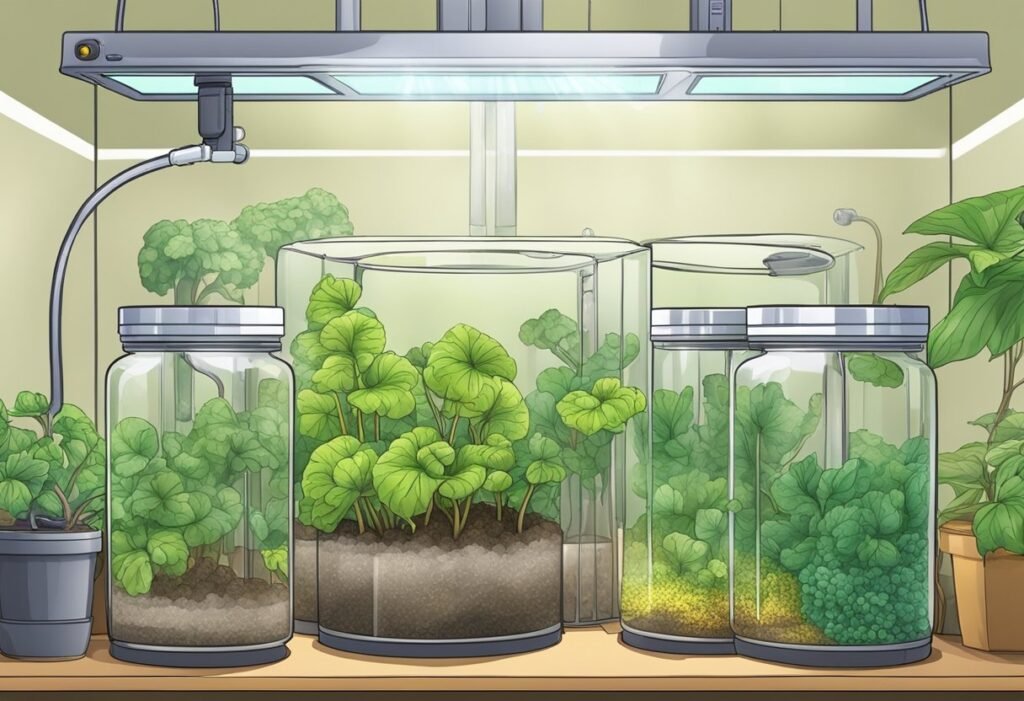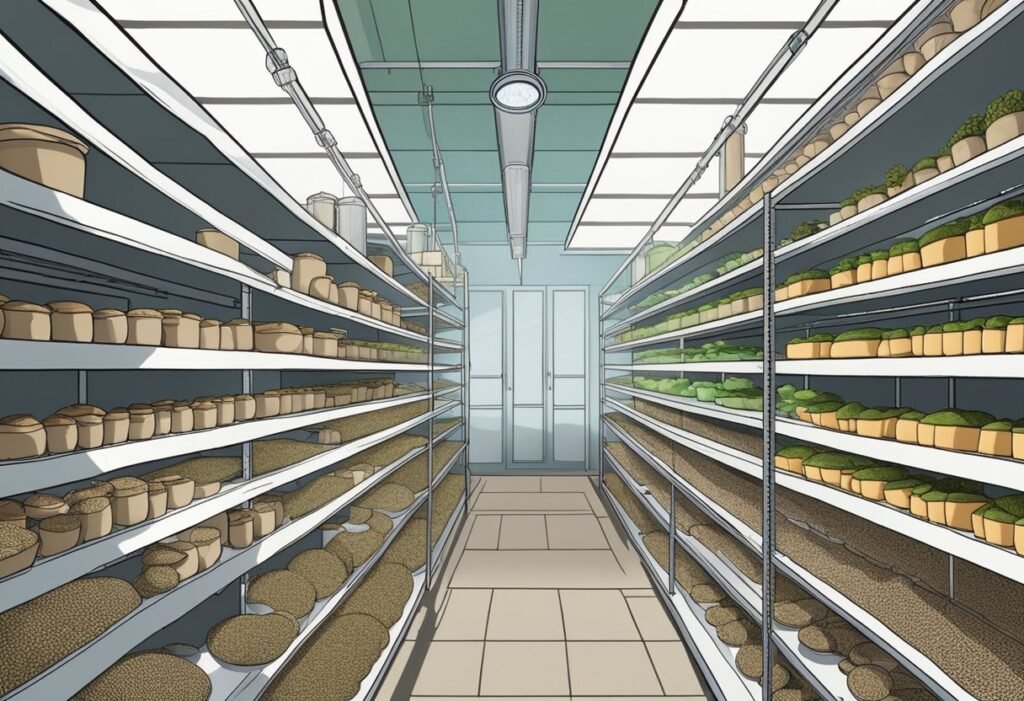Growing cubensis mushrooms at home can be a rewarding and fascinating experience. Cubensis mushrooms, also known as magic mushrooms, contain the psychoactive compounds psilocybin and psilocin, which can induce powerful psychedelic experiences. While the cultivation process can be challenging, with the right materials and techniques, it is possible to grow cubensis mushrooms in the comfort of your own home.

To begin, it is important to understand the basic requirements for growing cubensis mushrooms. These mushrooms require a nutrient-rich substrate, such as brown rice flour and vermiculite, as well as a warm and humid environment. The spores can be purchased online or obtained from a mushroom grower, and are typically grown in jars or bags. The process involves sterilizing the substrate and inoculating it with spores, then allowing the mycelium to colonize the substrate before inducing fruiting.
While the process may seem daunting, there are many resources available online that provide detailed instructions and tips for growing cubensis mushrooms. It is important to follow these instructions carefully and maintain a sterile environment to avoid contamination. With patience and persistence, growing cubensis mushrooms can be a rewarding and enriching experience.
Understanding Cubensis Mushrooms

Cubensis mushrooms, also known as psilocybin mushrooms, are a type of psychedelic mushroom that contains the psychoactive compound psilocybin. These mushrooms are commonly used for their hallucinogenic properties and have been used for centuries in traditional spiritual practices.
Cubensis mushrooms are relatively easy to grow and can be cultivated indoors using a variety of methods. They require a growing medium, such as brown rice flour, vermiculite, or a mixture of the two, and a spore syringe or spore print to inoculate the growing medium.
Once the growing medium has been inoculated with spores, the mycelium will begin to colonize the substrate. This process can take anywhere from a few days to a few weeks, depending on the growing conditions.
Cubensis mushrooms require a specific set of environmental conditions to fruit, including the right temperature, humidity, and lighting. They also require proper ventilation to prevent the growth of mold and other contaminants.
Overall, understanding the basic biology and growing requirements of cubensis mushrooms is essential for successful cultivation. With the right tools and techniques, anyone can grow their own supply of this fascinating and powerful psychedelic mushroom.
Creating an Ideal Growth Environment

When growing Psilocybe cubensis mushrooms, it is crucial to create an ideal growth environment to ensure a successful harvest. This section will discuss the two main factors that affect mushroom growth: temperature and humidity, and lighting and ventilation.
Temperature and Humidity
Maintaining the proper temperature and humidity levels is essential for the growth of Psilocybe cubensis mushrooms. The ideal temperature range for the cultivation of these mushrooms is between 22°C – 27°C (70°F – 80°F). The humidity level should be around 90%, but it’s important to note that too much humidity can lead to contamination.
One way to regulate the temperature and humidity levels is by using a grow tent or a grow box. These enclosed spaces allow for greater control over the environment and can be equipped with a humidifier and heater to maintain the desired levels.
Lighting and Ventilation
While Psilocybe cubensis mushrooms do not require light to grow, it is still important to provide a small amount of indirect light to help with the formation of the fruiting body. A 12-hour light cycle is sufficient, and natural light or a low-wattage bulb can be used.
Proper ventilation is also crucial for the growth of these mushrooms. A small fan can be used to circulate air within the grow space and prevent the buildup of carbon dioxide. Additionally, fresh air should be introduced periodically to prevent stale air from inhibiting growth.
By maintaining the proper temperature and humidity levels and providing adequate lighting and ventilation, growers can create an ideal growth environment for Psilocybe cubensis mushrooms.
Preparing the Substrate
Choosing the Right Material
The substrate is the material that mushrooms grow on. For Psilocybe cubensis, a popular choice is a mixture of coco coir, vermiculite, and gypsum. Another option is a substrate consisting of brown rice flour, vermiculite, and water. Some mushroom growers also use hardwood sawdust, straw, coffee grounds, rye grain, manure, logs, cardboard, or popcorn grain.
When choosing a substrate, it is important to consider factors such as availability, cost, nutrient content, and ease of preparation. Coco coir, for instance, is a popular choice because it is inexpensive, widely available, and easy to handle. Brown rice flour, on the other hand, is more expensive but is known to produce high yields.
Sterilization Process
Once the substrate has been chosen, it needs to be sterilized to kill any bacteria or other contaminants that could compete with the mushroom mycelium. Sterilization can be done using a pressure cooker, an autoclave, or a large pot of boiling water.
The exact sterilization process will depend on the type of substrate being used. For example, brown rice flour substrate can be sterilized in half-pint jars in a pressure cooker for about 90 minutes. Coco coir substrate, on the other hand, can be pasteurized using boiling water or a hot water bath.
It is important to follow the sterilization instructions carefully to ensure that the substrate is properly sterilized and free of contaminants. Failure to do so can result in low yields or even complete failure of the mushroom grow.
Inoculation and Colonization
Spore Syringe Preparation
Before inoculating the substrate, the spore syringe must be prepared. The spore syringe should be stored in a cool, dark place until it is ready to use. To prepare the spore syringe, shake it vigorously to distribute the spores evenly. Then, remove the cap and sterilize the needle by holding it in a flame until it turns red hot. Allow the needle to cool before proceeding.
Inoculation Procedure
Once the spore syringe is prepared, the next step is to inoculate the substrate. The substrate can be made of a variety of materials, including rice, vermiculite, or brown rice flour. To inoculate the substrate, inject the spores into the substrate using the sterilized needle. The injection sites should be spaced evenly throughout the substrate to ensure even colonization.
After the spores have been injected into the substrate, cover the inoculated substrate with a layer of vermiculite or other suitable material to prevent contamination. The inoculated substrate should then be placed in a warm, dark place to allow the spores to germinate.
Colonization Stage
The colonization stage is when the mycelium begins to grow and spread throughout the substrate. This process can take anywhere from one to four weeks, depending on the temperature and humidity levels. During this stage, it is important to maintain a suitable environment for the mycelium to grow, including proper temperature and humidity levels.
Once the substrate has been fully colonized by the mycelium, it is ready to be transferred to a fruiting chamber. The fruiting chamber should be kept at a slightly lower temperature and higher humidity to encourage the growth of the mushrooms. With proper care and attention, the mushrooms should be ready to harvest within a few weeks.
Fruiting and Harvesting
Inducing Fruiting
Once the substrate is fully colonized with mycelium, it is time to induce fruiting. This is done by exposing the substrate to a specific set of environmental conditions, including temperature, humidity, and light. The optimal temperature range for fruiting Psilocybe cubensis is between 70-75°F (21-24°C), with a humidity level of around 90%.
One way to achieve these conditions is by using a fruiting chamber, such as a monotub or a grow box. These chambers can be constructed using a variety of materials, including plastic containers, buckets, or even cardboard boxes. The key is to create a sealed, humid environment that allows for proper air exchange.
To induce fruiting, the substrate should be misted with water and placed in the fruiting chamber. Light is also an important factor in fruiting, and many growers use a 12-hour light cycle to simulate day and night. This can be achieved using a timer and a fluorescent light bulb.
Harvesting and Drying
Once the mushrooms have fully matured, they can be harvested by gently twisting and pulling them from the substrate. It is important to harvest the mushrooms before the caps begin to open, as this can reduce potency.
To dry the mushrooms, they can be placed on a wire rack or a piece of paper in a well-ventilated area. It is important to avoid direct sunlight or excessive heat, as this can degrade the potency of the mushrooms. A fan can be used to increase air circulation and speed up the drying process.
Once the mushrooms are fully dry, they can be stored in an airtight container, such as a mason jar or a plastic bag. It is important to label the container with the strain and date of harvest, as well as any other relevant information. Properly dried and stored mushrooms can remain potent for several months.




